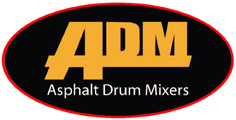C. M. CONSULTING
A Division of Cliff Mansfield Incorporated
Specializing in New & Used Asphalt Plants,
Sales, Parts, Service, Repairs,DEQ and
Mix Design Compliance and
Complete Consulting Services.
USEFUL NOTES & FORMULAS
GENERAL
A plant loses about 3% of its production rate per 1000 feet of elevation due to the thinning of the air.
Plants are designed to remove 5% moisture. The higher the moisture, the lower the production rate.
To Calculate A Batch Plant's Rate Of Production:
- Choose a weigh point on your aggregate scale (must be in a bin you are waiting on so that the pointer is rising slowly)
- With a stopwatch, determine the amount of time it takes the scales to return to this point - Time in seconds=(s)
- Divide (s) into the number of seconds per hour (3600)
- Multiply that answer by the average batch size (b)
- Assume the following: s=45seconds, b=5000# or 2.5 tons
- EXAMPLE: 3600 div. 45= 80 batches per hour
- 80x 2.5 = 200tph
To Calculate A Drum Plant's Rate Of Production:
- Multiply the aggregate tons per hour (x) times 100% minus the moisture content (y)
- Add the oil tons per hour (z)
- Assume the following: x= 209, y= 4.3%, z= 11.76
- EXAMPLE: 209x .957= 200.01
- 200.01+ 11.76= 211.77tph
To Convert Horsepower To KW:
- Multiply horsepower (h) by .7457
- Assume the following: h= 350hp
- EXAMPLE: 350x .7457= 261 KW
To Calculate The Length Of A Slat Conveyor At A 45 Degree Angle:
- Measure height (h), multiply by 1.41416
- Assume the following: h= 65'
- EXAMPLE: 65x 1.41416= 91.9204 feet long slat at 45 degrees
To Calculate The Speed In Feet-Per-Minute Of A Slat Conveyor, The Following Information Is Needed:
- Motor RPM- (rpm)
- Motor sheave size- (ms)
- Driven sheave size- (ds)
- Gear box ratio- (gbr)
- Head sprocket size- (hs)
- Assume the following: Rpm= 1755, ms= 8", ds= 14", gbr= 25.13 to 1 and hs= 9"
- Calculate the sheave ratio, i.e.: 8" drive, 14" driven
- Multiply motor speed by the answer = input RPM
- Input RPM divided by gear box ratio x diameter of head pulley x .2618= slat speed in Feet Per Minute
- EXAMPLE: 8 divided by 14 = .571 x 1755 = 1002.86 input rpm div. 25.13 gbr = 39.91 head shaft rpm 39.91 x 9 = 359.19 x .2618 = 94.04 FPM
ASPHALT OIL
To Find Asphalt % By Total Mix:
- Add oil to aggregate then divide oil by total of the two
- Assume the following: 250 tons aggregate used, 15 tons oil used
- Example: 250agg + 15oil = 265 15 div 265 = .0566% oil by total
To Calculate Where You Should Be Running With A Known Aggregate Tph:
- TPH of dry aggregate x % of oil, div. 100-% of oil = oil tph
- Assume the following: 70tph aggregate (dry), 5.4% oil
- Example: 100% - 5.4% = 94.6 70 tph x 5.4% = 378 div 94.6 = 3.99 tph of oil
To Find The Number Of Gallons Delivered On A Particular BILL OF LADING:
- Net weight in pounds (x), divide 8.328 (pounds per gallon of water, which has a specific gravity of 1.0) = y
- Divide y by the specific gravity (z) listed on the delivery ticket for the oil you are using
- Assume the following: x= 66,920, z= 1.0273
- Example: 66,920 divide 8.328= 8,035.54 (y)
- 8,035.54 divide 1.0273 (z)= 7,822 gallons at 60 degrees Fahrenheit
To Find Asphalt Gallons Per Ton:
- Look up AC pounds per gallon at the oil's temperature (x)
- Divide that number into 2000
- Assume the following: x = 7.81
- Example: 2000 div. 7.81 = 256.08 gallons AC per ton at the chosen temperature
To Convert Gallons Of Oil To Tons:
- Look up AC pounds per gallon at the oil's temperature (x)
- Multiply that number by number of gallons
- Divide that number by 2000
- Assume the following: x = 7.81
- Example: 7.81 ppg x 25,000 gals = 195,250# div
- 2000 = 97.625 tons of oil at (x) temperature
To Find Out How Many Tons Of Oil Are In An AC Tank:
- Check oil temperature (t)
- Measure liquid, convert inches to gallons (g)
- Find temperature on compensation chart and get conversation factor (f)
- Read oil pounds-per-gallon* at 60 degrees (p)
- Assume: t= 325 degrees
- g= 12,834 gallons, f= .9105, p= 8.456
- Example: 8.456 x .9105= 7.699ppg at 325 degrees
- 7.699ppg x 12,834gals = 98,811.37 pounds
- 98,811.37 # divide 2,000 = 49.41tons of oil
To Figure Out How Much Mix You Can Make With A Given Quantity Of Oil:
- Tons oil divided by percent of oil in mix = yield
- Example: 28 tons div. .055%= 509.09 tons of hot mix produced
To Find Pounds-Per-Gallon Of Any Oil:
- Find specific gravity listed on 'bill-of-lading' (g)
- Multiply pounds-per-gallon of water (8.33)* by the specific gravity (g) of the oil
- Assume: g= 1.0273 {actual reading for Oregon PBA-2} w= 8.33
- Example: 8.33 x 1.0273= 8.56pounds-per-gallon for the oil at 60 degrees
* Actual ppg of water
To Find The US Gallons Capacity Of A Cylindrical Tank:
- Measure the diameter (d) and the length (l)
- Square the diameter, multiply by length, then multiply by .0034
- Assume: d= 95", l= 337"
- Example: 95x 95x 337x .0034= 10,341 gallons
BAGHOUSE
It requires approximately 165 CFM of air to produce 1 ton of hot mix.
To Find The Correct Baghouse Size For A Particular Drum:
- Radius x radius x 3.142 (pi) x *1000= CFM required
- Example: Assume a 9 foot drum. 4.5 x 4.5 = 20.25 x 3.142 = 63.6255 x 1000 = 63,625.5 CFM
- This drum would require a 65,000 CFM baghouse
*1000 equals the air velocity through the dryer/mixer. This figure is usually down around 750 to 850fpm, but using 1000fpm give a little bit of oversizing which is a good thing since you don't want the air flow through the baghouse to limit production rates.
To Find The Square Feet Of Cloth In A Particular Baghouse, You Need To Know The The Diameter Of Bag (D), Length Of Bags (L), And Number Of Bags (N):
- The formula is: D x 3.142 = A
- A div 12 = B
- B x L = SF (sq. ft. per bag)
- SF x N = total sq. ft. of cloth in baghouse
To Find Air To Cloth Ratio (Should Be 5.1 To 1 In Batch, And 5.5 To 1 In Drum Plants)
- Determine square footage of an individual bag (X)
- Multiply that by the number of bags (Y)
- Divide that answer by baghouse CFM (Z). X times Y = total square feet of cloth (sq/ft). Z divide sq/ft = air to cloth ratio
Most manufacturers figure drum air velocity at between 900 & 1000 FPM.
CONVEYORS
To Find The Speed Of The Conveyor:
- Calculate the sheave ratio, i.e.: 10" drive, 18" driven
- 10 divided by 18 = .555 Multiply motor speed by the answer = input RPM
- Input RPM divided by gear box ratio x diameter of head pulley x .2618= belt speed in FPM
- Example: Assume an 1800 RPM motor, a 25-1 gear box and an 28" head pulley: 1800 x .555= 999 divide 25 = 39.96 x 28= 1118.88 x .2618= 292.92 FPM
To Zero Ramsey 10-201 Belt Scales (Total Tons In Lifetime)
- Press: Set-up - 76 - Enter
- 1853 - Enter - Enter
PUMPS
- HL225 .01898 gallons per revolution
- K225 .1055 gallons per revolution
- L225 .23 gallons per revolution
- 2"Q34 .23 gallons per revolution
- 3"Q34 .61 gallons per revolution
Please email us with your thoughts and/or questions.
Cliff - USA cmconsulting@hotmail.com
Copyright © 2023 C. M. Consulting. All Rights Reserved.





